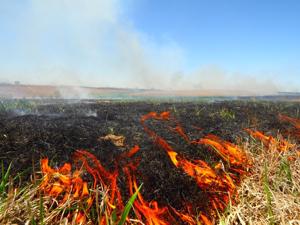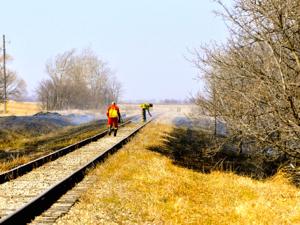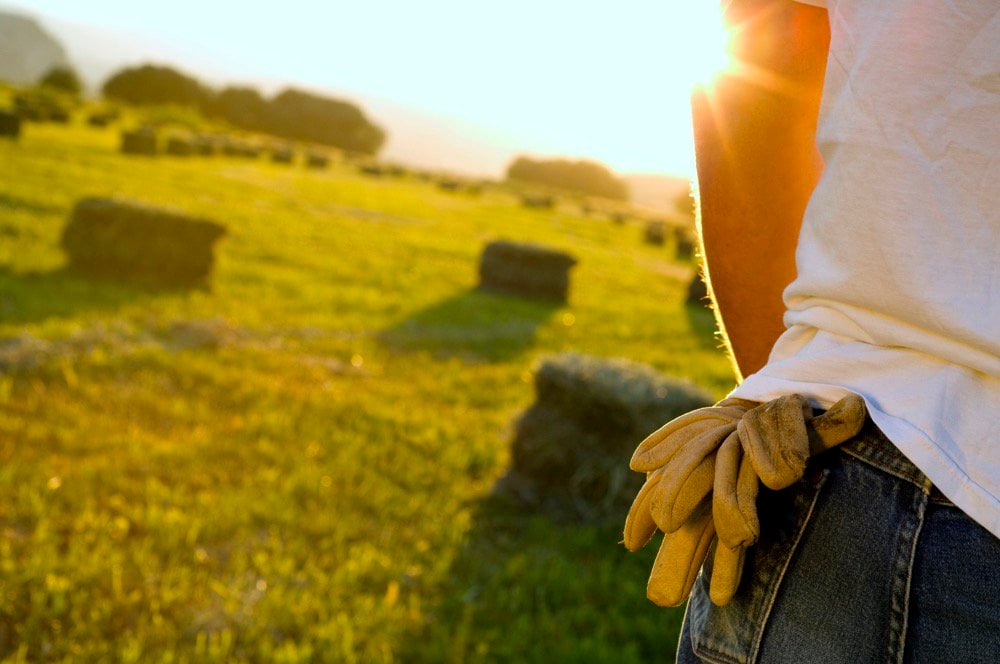We all say it couldn't, but it can happen to you

Whether it’s close to home or across an ocean, fire hasn’t been far from the news this summer.
This year has been average in terms of fire risk on the Prairies, says Mike Flannigan, professor of wildland fire and the director of the western partnership for wildland fire science at the University of Alberta.
But the risks increase in the autumn, when grain and Prairie grasses have dried out.
This fall, take steps to protect your operation from the worst-case scenario.
1. Understand fire risks

It’s important for producers to understand the risks wildfires pose to their operations, their livestock and farm animals — and their families.
For fires to occur, says Flannigan, three ingredients are needed: dry fuel to feed the fire, ignition, and hot, dry weather.
Weather is key, because it influences fuel moisture levels, and because windy conditions can play a role in starting fires — through blown power lines, for instance — and moving them faster.
Grass fires in the Prairies can be just as deadly as forest fires. “A lot of people don’t treat grass fires with the respect they deserve,” says Flannigan. “Grass fires can be a metre or three feet tall, and the temperatures can be very high. They can cause severe burns or, if you breathe in the flames, they can kill you.”
2. Use caution working with fire

Most wildfires are started inadvertently through human activity.
Flannigan says that when it’s hot, dry and windy and there are abundant dry fuels, particularly in spring and fall, producers should be careful of any activities that generate sparks or open flames.
“Burn when appropriate, and even if there is no fire ban and it’s really hot, dry and windy, burn another day,” he says.
Doug Lapchuk, president of the Saskatchewan Volunteer Firefighters Association and deputy chief in Balgonie, Sask., recommends producers create a fire break before starting a burn (for example, tilling a strip around the burn area), keep someone working the fire line in case the wind picks up, and have a source of water close at hand to extinguish the fire if necessary.
3. Make a plan

FireSmart Canada offers resources and materials to help communities and individuals plan for the risk of fire.
On the FireSmart website, producers can complete area and site assessments to evaluate risks to land and structures. FireSmart also has a special publication, the FireSmart Farm and Ranch Magazine, which considers the unique fire planning needs of farming communities.
“You should have a plan in place for wildfires or grassfires, just like you would for a house fire,” says Flannigan. “This is where the FireSmart manual comes in handy. A lot of it is common sense. Fire is opportunistic, looking for a pathway. If you provide a pathway you’re at risk.”
Flannigan adds a few practical suggestions for farmers: move fuel sources away from homes and buildings, install sprinkler systems in barns, and keep portable pumps and hoses handy to wet down buildings using nearby sloughs.
If producers have animals on their operations, they should have a plan in place for moving animals out of harms’ way well before fire reaches barns.
“Keep trash down, and keep buffer zones between your windbreaks and windrows or trees to your property so that fire can’t jump as easily from the bush to your buildings,” adds Lapchuk.
“Remember to respect fire — it’s a living entity, it’s not discriminatory. If you remove fuel or ‘food’ the fire can’t grow,” he says.
4. Act fast in an emergency

Protecting oneself and one’s family should always be top-of-mind if the worst-case scenario occurs.
Flannigan says mandatory evacuations are decided by situation or jurisdiction, and if mandatory evacuations are not in place it can be difficult for firefighters to convince home- or landowners to leave.
But if the risk is real, err on the side of caution and leave early, says Flannigan; people tend to die in fires when they try to evacuate at the last minute.
If there is time to do so, farmers should get on the tractor and plough one or two rows around homes and barns and anything else of value. “That’s the best protection you have, because you’re taking the fuel away,” he says.
First things first, though, Lapchuk says producers shouldn’t ever hesitate to call the fire department. “The sooner we get there the sooner we stop the fire,” he says.
This could happen to you

We had real world experience with a fire on the farm near Griffin, Sask., on August 19, when our neighbours’ house caught fire. We were lucky on several counts: none of the family were in the house; some neighbours noticed the fire, despite all the forest fire smoke clouding the air that day; the fire didn’t move beyond the yard — it was a windy day, and a fire could have travelled a long way.
“Keep a disc ready to hook up to your tractor, just in case,” is not on the list in Julienne Isaacc’s story here, but it probably should be. My husband, Brad Barlow, in the tractor in this photo, tries to remember to do this every fall. This year, preparation paid off.
– Leeann Minogue, Grainews editor












